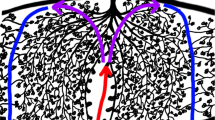Abstract
Purpose
The aim of this study was to evaluate the utility of added DWI sequences as an adjunct to traditional MR imaging in the evaluation of abnormal placentation in patients with suspicion for placenta accreta spectrum abnormality or morbidly adherent placenta (MAP).
Materials and methods
The study was approved by local ethics committee. The subjects included pregnant women with prenatal MRI performed between July 2013 to July 2015. All imaging was performed on a Philips 1.5T MR scanner using pelvic phased-array coil. Only T2-weighted and diffusion-weighted imaging (DWI) series were compiled for review. Two randomized imaging sets were created: set 1 included T2-weighted series only (T2W); set 2 included T2W with DWI series together (T2W + DWI). Three radiologists, blinded to history and pathology, reviewed the imaging, with 2 weeks of time between the two image sets. Sensitivity, specificity, and overall accuracy for MAP were calculated and compared between T2W only and T2W + DWI reads. Associations between imaging findings and invasion on pathology were tested using the Chi-squared test. Confidence scores, inter-reader agreement, and systematic differences were documented.
Results
A total of 17 pregnant women were included in the study. 8 cases were pathologically diagnosed with MAP. There were no significant differences in the diagnostic accuracy between T2W and T2W + DWI in the diagnosis of MAP in terms of overall accuracy (62.7% for T2W vs. 68.6% for T2W + DWI, p = 0.68), sensitivity (70.8% for T2W vs. 95.8% for T2W + DWI, p = 0.12), and specificity (55.6% for T2W vs. 44.4% for T2W + DWI, p = 0.49). There was no significant difference in the diagnostic confidence between the review of T2W images alone and the T2W + DWI review (mean 7.3 ± 1.8 for T2W vs. 7.5 ± 1.8 for T2W + DWI, p = 0.37).
Conclusion
With the current imaging technique, addition of DWI sequence to the traditional T2W images cannot be shown to significantly increase the accuracy or reader confidence for diagnosis of placenta accreta spectrum abnormality. However, DWI does improve identification of abnormalities in the placental–myometrial interface.




Similar content being viewed by others
References
Mazouni C, Gorincour G, Juhan V, Bretelle F (2007) Placenta accreta: a review of current advances in prenatal diagnosis. Placenta 28:599–603
Silver RM (2004) The MFMU cesarean section registry: maternal morbidity associated with multiple repeat cesarean delivery. Am J Obstet Gynecol 191:S17
Clark SL, Koonings PP, Phelan JP (1985) Placenta previa/accreta and prior cesarean section. Obstet Gynecol 66:89–92
Derman AY, Nikac V, Haberman S, et al. (2011) MRI of placenta accreta: a new imaging perspective. Am J Roent 197(6):1514–1521
Shweel MAG, El Ameen NF, Ibrahiem MA, Kotib A (2012) Placenta accreta in women with prior uterine surgery: diagnostic accuracy of Doppler ultrasonography and MRI. Egypt J Rad NM 43(3):473–480
Florence B, Blandine C, Chafika M, et al. (2007) Management of placenta accreta: morbidity and outcome. Eur J Obstet Gynecol Reprod Biol 133:34–39
Andrew DH, Thomas RM (2011) Multiple repeat cesareans and the threat of placenta accreta: incidence, diagnosis, management. Clin Perinatol 38:285–296
Wu S, Kocherginsky M, Hibbard JU (2005) Abnormal placentation: twenty-year analysis. Am J Obstet Gynecol 192:1458–1461
Konijeti R, Rajfer J, Askari A (2009) Placenta percreta and the urologist. Rev Urol 11:173–176
Baughman WC, Corteville JE, Shah RR (2008) Placenta accreta: spectrum of US and MR Imaging Findings. Radiographics 28(7):1905–1916
Morita S, Ueno E, Fujimura M, et al. (2009) Feasibility of diffusion-weighted MRI for defining placental invasion. J Magn Reson Imaging 30(3):666–671
Landis JR, Koch GG (1977) The measurement of observer agreement for categorical data. Biometrics 33(1):159–174
Gao Sujuan, Liu Bin, Cao Yanmin (2016) The comparison of MRI and Ultrasound in prenatal identification of invasive placentation: a meta-analysis based on 20 parallel control studies. Int J Clin Exp Med 9(6):9932–9942
Derman Anna Y, Nikac Violeta, Haberman Shoshana, et al. (2011) MRI of placenta accreta. AJR 197:1514–1521
Lax A, Prince MR, Mennitt KW, Schwebach JR, Budorick NE (2007) The value of specific MRI features in the evaluation of suspected placental invasion. Magn Reson Imaging 25:87–93
Riteau AS, Tassin M, Chambon G, et al. (2014) Accuracy of ultrasonography and magnetic resonance imaging in the diagnosis of placenta accreta. PLoS One 9:e94866
Yamashita Y, Namimoto T, Abe Y, et al. (1997) MR imaging of the fetus by a HASTE sequence. AM J Roentgenol 168:513–519
Kim JA, Narra VR (2004) Magnetic resonance imaging with true fast imaging with steady-state precession and half-Fourier acquisition single-shot turbo spin-echo sequences in cases of suspected placenta accreta. Acta Radiol 45:692–698
Einerson BD, Rodriguez C, Kennedy AM, Woodward PJ, Silver RM (2017) Accuracy and inter-observer variability of magnetic resonance imaing findings for the prediction of morbidly adherent placenta. Am J Obstet Gynecol. 216(1):S164–S165
Bowman ZS, Eller AG, Kennedy AM, et al. (2014) Interobserver variability of sonography for prediction of placenta accreta. J Ultrasound Med 33:2153–2158
Author information
Authors and Affiliations
Corresponding author
Ethics declarations
Disclosure of potential conflicts of interest
None.
Funding
No funding was received for this study.
Ethical approval
All procedures performed in studies involving human participants were in accordance with the ethical standards of the institutional and/or national research committee and with the 1964 Helsinki Declaration and its later amendments or comparable ethical standards.
Informed consent
Retrospective study, hence no informed consents were obtained.
Rights and permissions
About this article
Cite this article
Sannananja, B., Ellermeier, A., Hippe, D.S. et al. Utility of diffusion-weighted MR imaging in the diagnosis of placenta accreta spectrum abnormality. Abdom Radiol 43, 3147–3156 (2018). https://doi.org/10.1007/s00261-018-1599-8
Published:
Issue Date:
DOI: https://doi.org/10.1007/s00261-018-1599-8




